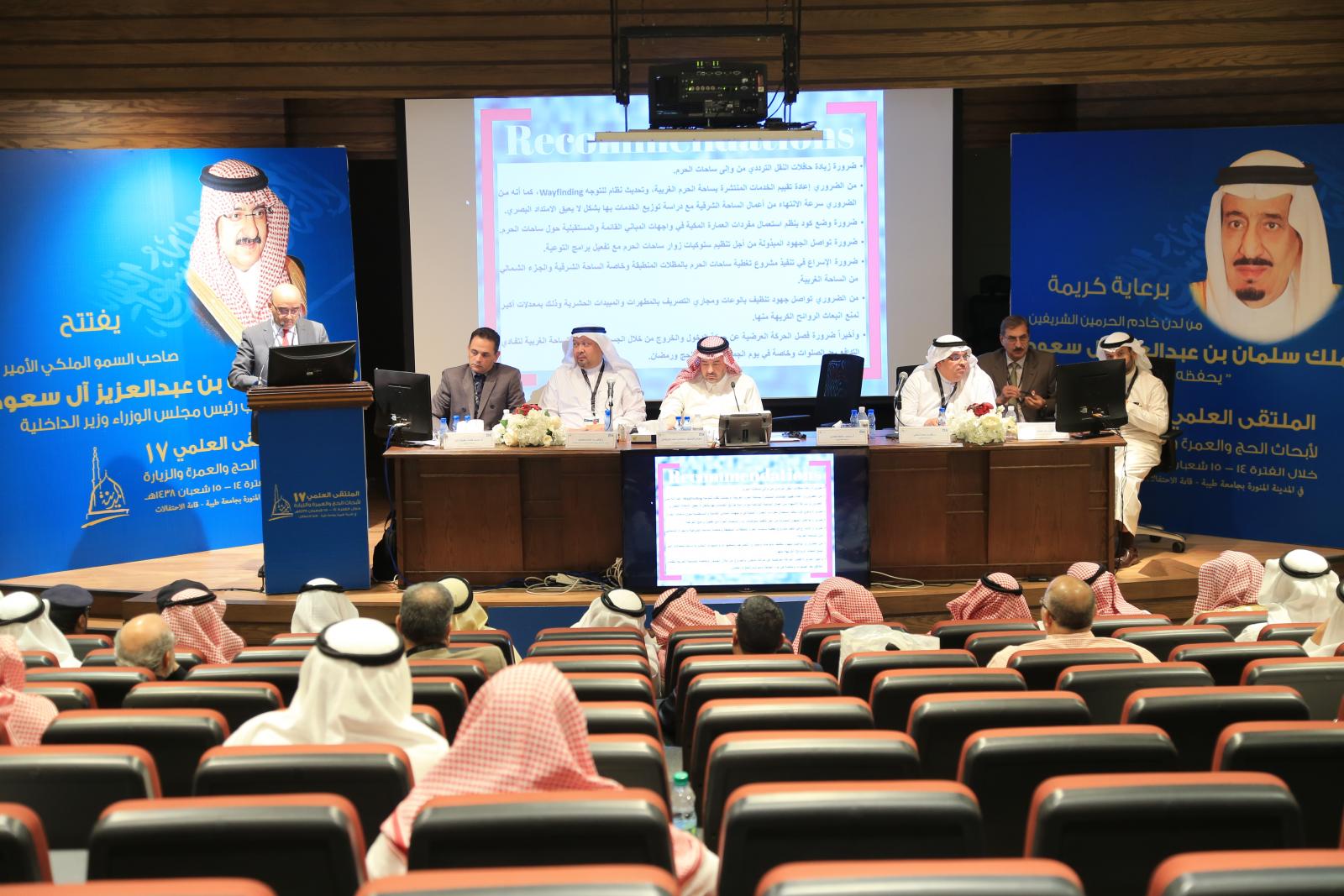
At the concluding meetings of the Forum’s first day, participants in the Scientific Forum for Hajj, Umrah and Visit Research explored six working papers in the fourth session chaired by the president of the Islamic University in Madinah Dr. Hatem H. Al-Marzouki on “Urban and Engineering Studies”.
In their paper entitled “Preserving the Islamic Architectural Identity for the Two Holy Mosques’ Urban Surroundings”, Dr. Mohammad Khalil and Dr. Mohammad Atef – UQU College of Engineering and Islamic Architecture – addressed consolidating the Islamic identity of the buildings around the Two Holy Mosques, noting the importance of determining a style for architectural design based on the properties of Islamic Heritage, to harmonize and integrate past, present and future styles, and to develop a vision to redesign such particulars in their modern concepts.
They elaborated on the identity of Islamic architecture, its inherent heritage values in the architecture of the Two Holy Mosques, and how to reflect its particulars in a modern framework to revive them while meeting today’s requirements to cope with the multiple purposes of neighboring buildings, including residential, commercial, hotel and administrative ones, as well as preserving such heritage values to ensure their restoration, durability and sustainability.
In the same session, Dr. Ibrahim Al Bidewi – King Abdulaziz University in Jeddah – presented his paper on “Using Smart Buildings to Increase the Capacity of Muzdalifah”, where he outlined a patent issued by King Abdulaziz City for Science and Technology for a smart building in Muzdaifah, which will solve the issue of constrained geographical area and the uncontrolled stay. In the same context, he listed the positive aspects of the proposed building and its capacity, coupled with a description of the building’s design and how it functions.
In his paper on “Proposal to Expand the Visit to the Prophet’s Tomb in Madinah” Dr. Iyad Al-Zaidi – King Abdulaziz University – proposed to expand the available space for visit in an effective innovative and engineering way to solve the issue of congestion by the Prophet’s Tomb – peace be upon him – for men, women and special needs individuals simultaneously, especially during seasons. “We can increase the capacity to about 18 times more, that is to say 88,000 visitors per hour.”, he added.
He noted that the project would use moving walkways beyond the current visit area in three stages, with unique bi-directional horizontal and vertical ascents and descents, with different speeds and lengths, and enclosed by smart glass. “This system allows great organization, peace and serenity during visit while facing the Prophet’s Tomb all the time irrespective of the user’s location. It will also afford the visitor ample time without stopping to greet the Prophet – peace be upon him, thus eliminating noise around the Prophet’s Room during construction.” Stressed Dr. Ayad.
In addition, in a joint paper entitled “The religious Open Spaces – a Case Study of the Outdoor Spaces around the Holy Mosque”, Dr. Mohammad Khalil and Dr. Mohammad Atef – UQU College of Engineering and Islamic Architecture – detailed the importance of developing the open courtyards to enhance spiritual feelings, provide safety, achieve comfort, and integrate more activities, stating that this can be obtained through good management of the spaces to attract more individuals. The Holy Mosque in Makkah is taken as a case study, while analyzing its historical background against the present situation, and highlighting the key challenges facing visitors to such vital yards, then providing the essential perspectives and alternatives to overcome such challenges.
Also, in their paper on “A Methodology to Develop Key Indicators to Measure the Performance of Hajj and Umrah Services and Facilities”, Dr. Sami bin Yassin Barhamain and Dr. Ayman Mohammad Mustafa – from the Custodian of Two Holy Mosques Institute for Hajj and Umrah Research – addressed the need to create key indicators to measure the performance of Hajj and Umrah services and facilities in line with the 2030 Vision of the Kingdom. “KPIs serve as a planning and remedial tool to measure progress of the steps taken to improve. KPIs yield greater value when they are connected to development policies, as well as when projects are designed to overcome operational challenges, and all stakeholders in Hajj and Urmrah services and facilities have access to them via direct engagement in their development and use.”, they said.
Moreover, in a joint paper entitled “The Actual Number of Praying Individuals During Hajj in the Prophet’s Mosque”, Dr. Wael Saleh Al Halabi – UQU, Dr. Hamed bin Omar Al Bar and Dr. Ali bin Yaslam Ba-Obaid – King Abdulaziz University, confirmed that calculating the actual numbers of praying individuals will contribute to developing a better perception on the pattern and density of using the Mosque’s spaces, as well as the roads leaning thereto. They noted that they have calculated the incoming individuals to the Prophet's Mosque until the end of Friday prayers, taking Friday, Dhul-Hijjah 22nd, 1437 A.H. as an indicator of the peak time during the second season of Hajj in 1437 A.H. The same was applied to Friday, Moharram 20th, 1438 A.H. as an indicator of the off-peak period.